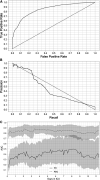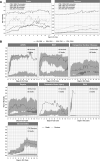The criticality Index-mortality: A dynamic machine learning prediction algorithm for mortality prediction in children cared for in an ICU
- PMID: 36533242
- PMCID: PMC9752098
- DOI: 10.3389/fped.2022.1023539
The criticality Index-mortality: A dynamic machine learning prediction algorithm for mortality prediction in children cared for in an ICU
Abstract
Background: The Criticality Index-Mortality uses physiology, therapy, and intensity of care to compute mortality risk for pediatric ICU patients. If the frequency of mortality risk computations were increased to every 3 h with model performance that could improve the assessment of severity of illness, it could be utilized to monitor patients for significant mortality risk change.
Objectives: To assess the performance of a dynamic method of updating mortality risk every 3 h using the Criticality Index-Mortality methodology and identify variables that are significant contributors to mortality risk predictions.
Population: There were 8,399 pediatric ICU admissions with 312 (3.7%) deaths from January 1, 2018 to February 29, 2020. We randomly selected 75% of patients for training, 13% for validation, and 12% for testing.
Model: A neural network was trained to predict hospital survival or death during or following an ICU admission. Variables included age, gender, laboratory tests, vital signs, medications categories, and mechanical ventilation variables. The neural network was calibrated to mortality risk using nonparametric logistic regression.
Results: Discrimination assessed across all time periods found an AUROC of 0.851 (0.841-0.862) and an AUPRC was 0.443 (0.417-0.467). When assessed for performance every 3 h, the AUROCs had a minimum value of 0.778 (0.689-0.867) and a maximum value of 0.885 (0.841,0.862); the AUPRCs had a minimum value 0.148 (0.058-0.328) and a maximum value of 0.499 (0.229-0.769). The calibration plot had an intercept of 0.011, a slope of 0.956, and the R2 was 0.814. Comparison of observed vs. expected proportion of deaths revealed that 95.8% of the 543 risk intervals were not statistically significantly different. Construct validity assessed by death and survivor risk trajectories analyzed by mortality risk quartiles and 7 high and low risk diseases confirmed a priori clinical expectations about the trajectories of death and survivors.
Conclusions: The Criticality Index-Mortality computing mortality risk every 3 h for pediatric ICU patients has model performance that could enhance the clinical assessment of severity of illness. The overall Criticality Index-Mortality framework was effectively applied to develop an institutionally specific, and clinically relevant model for dynamic risk assessment of pediatric ICU patients.
Keywords: criticality index; dynamic outcome prediction; machine learning; mortality prediction; prediction algorithm.
© 2022 Patel, Trujillo-Rivera, Morizono and Pollack.
Conflict of interest statement
The authors declare that the research was conducted in the absence of any commercial or financial relationships that could be construed as a potential conflict of interest.
Figures




References
-
- Sauthier M, Landry-Hould F, Leteurtre S, Kawaguchi A, Emeriaud G, Jouvet P. Comparison of the automated pediatric logistic organ dysfunction-2 versus manual pediatric logistic organ dysfunction-2 score for critically ill children. Pediatr Crit Care Med. (2020) 21:E160–9. 10.1097/PCC.0000000000002235 - DOI - PubMed
Grants and funding
LinkOut - more resources
Full Text Sources

